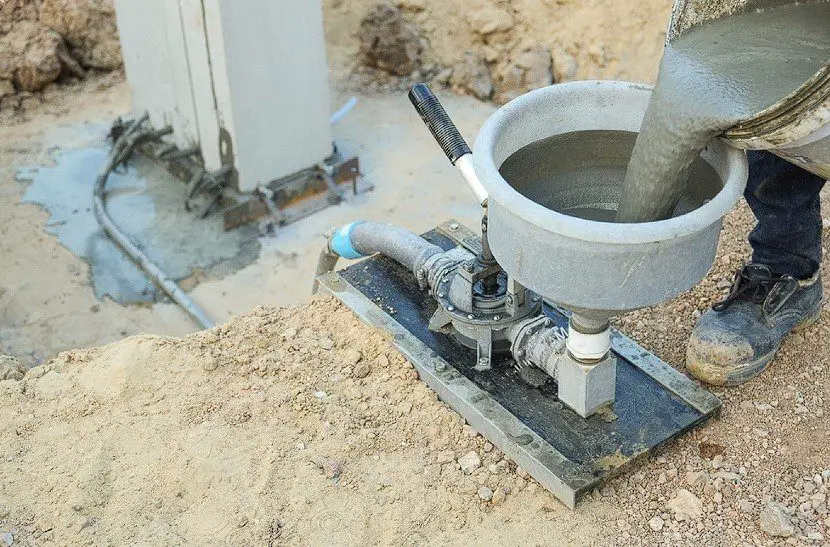This method statement for non-shrink grouting defines the work techniques, guidelines, as well as safety and quality standards for the use of non-shrink grout for applicable areas.
Scope
All grouting applications are covered under the scope of work for this procedure for the following area of applications:
Base plates
Machine bases, base plates for light and heavy machinery
References
PDS (Product Data Sheet)
MSDS (Material and Safety Data Sheet)
Project Specifications
Structural Steel Pipe Racks, Steel Supports & Miscellaneous *Steel Structures (Incl. Piping Supports per specification).
Structural Alignment prior to grouting.
Structural Steel Alignment Report.
Foundation and Supporting Structures for Heavy Machinery. Cement-based, Non-shrink grout for Structural and Equipment Grouting.
Cement-Based Non-Shrink Grout Surface Preparation & Formwork Inspection.
Mixing, Placement Sampling, Testing Curing, and Final Inspection.
Responsibilities
The Site Manager is responsible for ensuring that all necessary requirements are fulfilled on-site, including all HSE regulations, labor, materials, and equipment, in order to complete grouting activities on time and according to project specifications.
Quality Control (QC) Inspector is responsible for providing inspection documents to the project, such as the Request for Inspection Form. Ensure that all grouting activities, from materials through installation, are carried out in accordance with the quality criteria.
The Construction Manager is in charge of implementing safety measures such as erecting barricades and warning signs, obtaining construction permits, etc.
Procedure for Non-shrink Grouting
General-Method Statement for Non-shrink Grouting
Prior to using for the actual grouting application, Non-Shrink Grout (SikaGrout®-212) materials must have available records of materials receiving inspection and acceptance as per specifications.
Prior to the final grouting application, all installed structural steel plates and supports must have records of inspection as per the Inspection and Test Plan, as well as an accepted final alignment report.
Preparation of cement-based non-shrink grout materials and formwork inspection shall be in accordance with specifications – mixing, placement, sampling, testing, curing, and final inspection.
The following step-by-step processes are based on the manufacturer’s recommendations and best practices for grouting applications:

Preparation of the Foundation
Before installing the base plate, the concrete surface to be grouted must be prepared for chipping with a chipping hammer, grit blasting, or high-pressure water jetting, as appropriate. Bush hammering or any other equivalent approach that can fracture or damage the surface and foundation is not permitted.
Chipping should cover the entire area that will come in touch with the grout. This will allow the grout to adhere to the chipped surface of the concrete with a firm bond.
If a bolt anchoring system to the grout is used, the bolt pocket formers should be formed into a cone to help prevent stresses from building up when the bolts are tightened and transmitted directly to the foundation.
Bolt pocket formers should be manufactured of materials that are simple to remove but leave a rough concrete texture when stripped.
The chipped concrete surface, base plates, and holding down bolts, among other things, must be cleaned and free of any oil, dust, debris, paint, or leftover curing compound that could compromise the bond.
Formworks
The surface foundation for formwork installation must be carefully cleaned, including bolt holes.
To prevent grout loss, fitted formworks around the base plates where grout is to be retained must be as watertight as necessary.
The top of the formwork must be at least 25mm higher than the bottom of the base plate. When large base plate pours are required, the formwork must be raised to allow a pressure head to form.
If grouting requires special equipment, such as a pump under pressure, the formworks must be anchored and able to withstand increased localized pressure. Formworks must be sealed with silicone adhesive in order to maintain form tightness and prevent water leakage during grouting.
Preparation for Grouting
Before beginning the grouting pouring application, make sure the formwork and concrete surface are free of any dirt, dust, and debris, and that they have been vacuumed and air blown.
Within 24 hours of grouting, the concrete surface within the formwork must be wet with water. Before grouting, make sure the surface is moist and in a suitable, acceptable temperature condition.
To enable a continuous grouting operation, mixing equipment must be suitable and in good operating order, with backup mixing equipment accessible in the event of equipment failure.
Drum-type mixers are allowed only if they are modified with a 12-15mm wire mesh above the blades inside the drum to help break up any grout balls that may occur.
Ensure that enough potable water is available for mixing and that the temperature is within the permitted range specified in the material specification.
Grouting is not permitted in hot weather if the ambient temperature exceeds the allowable limit, especially if the grouting is to be done in an exposed location. Grouting is only allowed if the region is shaded, the material does not exceed the ambient storage limit, and the grout mixture does not exceed the maximum mix at 26° C.
To guarantee that the grout mixture meets the specifications, a calibrated thermometer gauge must be available to monitor the grout components, water, and ambient temperature.
Any nearby machinery that may generate vibration at the pour location must be turned off.
Grout Mixing
After 24 hours of saturation compliance, fitted formworks must be assessed for probable leakage. Ensure that all standing water, including water from the bolt pockets and surrounding area, is removed prior to grout mixing. The concrete that will be poured with grout must be moist.
Ensure that the materials and water mixture is in compliance with the materials specifications specified in the materials technical datasheets.
A heavy-duty drill fitted with a suitable paddle should be used to mix the grout in each bag at a slow speed of 300-500 rpm (revolutions per minute) for a minimum of 3 minutes. A dedicated grout mixer must be used for multiple bags mixes to ensure consistency and a minimum permissible mixing time of 4-5 minutes to meet the acceptable and desired mixes prior to grout pouring.
When the grout mixture is lump-free, add enough water to achieve the desired consistency.
Take compressive test cube samples of non-shrink grouting materials, two (2) sets of 50 x 50mm cubes for each grouting operation.
Ensure that a copy of the grout cube compressive test results is submitted to the project consultant for their records.
Grout Application
Begin pouring grout from one end of the base plate and work your way down the slope of the formwork. Slowly move the pouring point along the length of the base plate when grout reaches the far edge of the formwork and rises above the bottom of the base plate to ensure regular and even pours within the formwork.
To avoid and prevent voids from forming within the formwork and below the foundation plates, all bolt pockets must be filled with grout and the fullness of the pouring grout must be secured.
Allow at least 3mm of grout filling above the bottom of the base plate to ensure a uniform and even filling and to prevent cracks during the curing process.
To avoid air entrapment, pour steadily down one side of the base plate to the slope of the formwork. To eliminate voids that can reduce the bearing area’s effectiveness, avoid pouring grout on separate sides.
Curing
After the grout is applied, wet rags should be used to cover the exposed edges to keep the grout moist for 24 hours. Hessian does not hold moisture effectively as compared to cloth ( a wet burlap is recommended for use and a plastic covering to maintain its moisture).
After 24 hours, the formworks can be removed, although it is recommended that they be stripped away after at least 7 days of curing to ensure a firm and effective bearing grout foundation. Within 7 days, continued curing with potable water and wet burlap is required.
Note: Strict curing time monitoring must be adopted to ensure moist curing within 24 hours to avoid cracking and holes forming if curing is not observed. It’s still advisable to adhere to the manufacturer’s curing recommendations, as detailed in the material’s technical datasheets.
Attachments
SikaGrout®-212-Material Specification
Material Safety Data Sheet
SikaGrout®-212-Job Safety Analysis Safety Datasheet (JSA)
